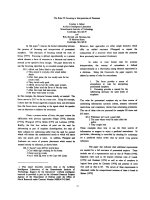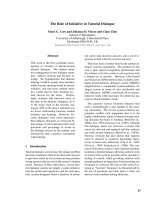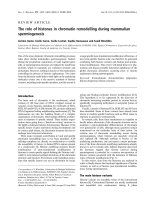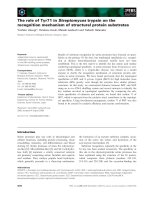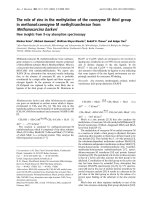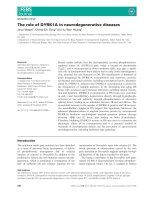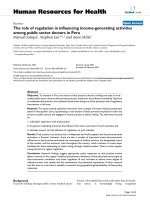báo cáo hóa học:"The role of disclosure in relation to assent to participate in HIV-related research among HIV-infected youth: a formative study" docx
Bạn đang xem bản rút gọn của tài liệu. Xem và tải ngay bản đầy đủ của tài liệu tại đây (188.34 KB, 10 trang )
BioMed Central
Page 1 of 10
(page number not for citation purposes)
Journal of the International AIDS
Society
Open Access
Research
The role of disclosure in relation to assent to participate in
HIV-related research among HIV-infected youth: a formative study
Amy Corneli*
1
, Lara Vaz
2
, Jennyfer Dulyx
1
, Serge Omba
3
, Stuart Rennie
4,5
and Frieda Behets
1
Address:
1
Department of Epidemiology, University of North Carolina at Chapel Hill, USA,
2
Department of Health Behavior & Health Education,
University of North Carolina at Chapel Hill, USA,
3
School of Public Health, University of Kinshasa, Kinshasa, Democratic Republic of Congo,
4
Department of Dental Ecology, University of North Carolina at Chapel Hill, USA and
5
Department of Social Medicine, University of North
Carolina at Chapel Hill, USA
Email: Amy Corneli* - ; Lara Vaz - ; Jennyfer Dulyx - ; Serge Omba - ;
Stuart Rennie - ; Frieda Behets -
* Corresponding author
Abstract
Background: The objective of this study was to develop a culturally appropriate approach for obtaining assent from
children aged eight to 17 years to participate in paediatric HIV-related operational research in Kinshasa, Democratic
Republic of Congo (DRC). Included within this objective was to determine whether or not HIV disclosure should be
included as part of the assent process prior to research participation, a component of research participation, or not
incorporated in any aspect of the child's involvement in the research. Factors that influence parents' and caregivers'
decisions to disclose HIV status to children in non-research contexts were also explored.
Methods: A qualitative formative study was conducted. Semi-structured interviews were conducted with 19 youth living
with HIV, 36 parents and caregivers of youth living with HIV, and 17 health professionals who provide care and support
to youth living with HIV and their families. Participants were purposefully selected from three HIV care, treatment and/
or psychosocial support programmes in Kinshasa, DRC.
Results: Most youth interviewed believed minors participating in HIV-related research should be informed of their HIV-
positive status. Parents and caregivers and health professionals had varied perspectives on if and when HIV status should
be disclosed to minors during research participation. The age of the youth influenced parents and caregivers' responses,
and disclosure to adolescents was more frequently supported than disclosure to children.
Several parents and caregivers, as well as some health professionals, suggested that minors should never be told their
HIV-positive status when participating in HIV-related research, regardless of their age. Within the context of treatment
programmes, disclosure of HIV status to minors was supported by youth, parents and caregivers, and health professionals
as a means to improve adherence to medication.
Conclusion: In settings where most minors are unaware of their HIV infection, researchers should consider excluding
the term, "HIV", when explaining HIV-related research to minors, and omitting it from assent forms or informational
sheets related to research participation. However, an individualized disclosure plan should be initiated with parents and
caregivers at the time of enrolment in HIV-related research, particularly in research that involves treatment.
Published: 27 August 2009
Journal of the International AIDS Society 2009, 12:17 doi:10.1186/1758-2652-12-17
Received: 7 March 2009
Accepted: 27 August 2009
This article is available from: />© 2009 Corneli et al; licensee BioMed Central Ltd.
This is an Open Access article distributed under the terms of the Creative Commons Attribution License ( />),
which permits unrestricted use, distribution, and reproduction in any medium, provided the original work is properly cited.
Journal of the International AIDS Society 2009, 12:17 />Page 2 of 10
(page number not for citation purposes)
Background
Within the context of operational research, we initiated a
paediatric HIV care programme that included free access
to antiretroviral treatment in Kinshasa, the Democratic
Republic of the Congo (DRC), the first of its kind in the
country. The aim of this operational research was to
develop a context-appropriate model of comprehensive
HIV care and treatment.
During the ethics review of the operational research, it was
recommended to obtain assent from children participat-
ing in the research, if culturally appropriate. No national
guidelines were available in the DRC for assent proce-
dures or disclosure of HIV status to HIV-infected children,
and local clinicians reported that few HIV-infected minors
in Kinshasa had been informed of their HIV status.
Additionally, at that time, very little was known in the
sub-Saharan African context about what role, if any, chil-
dren play in decision making on research participation,
and if, when and how children ought to be told they have
HIV. Further, research on the impact of inadvertent disclo-
sure prior to or during research participation was not well
studied.
In searching for other guidelines on paediatric HIV disclo-
sure, we learned that few guidelines exist; only US guide-
lines were found and they focus on US populations. The
American Academy of Pediatrics (AAP) recommends the
disclosure of HIV diagnosis to children and adolescents
[1]. For younger children, AAP recommends partial dis-
closure that involves a discussion regarding the illness,
but the child's diagnosis need not be disclosed. For
school-aged children, disclosure is recommended,
although a child's knowledge and coping ability should
be assessed prior to disclosure, and systems should be in
place to help the child cope with the diagnosis. AAP rec-
ommends that an HIV diagnosis be disclosed to adoles-
cents.
As for assent guidelines, according to US regulations [2],
children should provide assent to participate in research
taking into consideration age, risks, benefits and context.
In HIV-related research with HIV-infected minors, one
could argue that minors must be aware of their HIV status,
and that HIV must be mentioned in the assent form in
order for the assent to be meaningful. In a recent com-
mentary, Barfield and Kane [3] raise awareness of issues
surrounding meaningful assent from HIV-infected youth,
and suggest further dialogue on the delicate question of
how to balance disclosure and assent.
For our operational research, we questioned whether
minors should know the reason they would be receiving
care and treatment in order for the assent to be genuinely
informed. However, given the local context in Kinshasa of
limited disclosure to minors, we had serious concerns that
mentioning HIV on the assent form would disclose HIV
status to minors and possibly subject them to social and
psychological harm, given widespread HIV-related stigma
and discrimination in the local context.
For these reasons, we conducted a formative study from
July to September 2005 to determine the best assent
approach for our operational research. The objective of
the formative study was to develop a culturally appropri-
ate approach for obtaining assent from children aged
eight to 17 years to participate in the operational research;
the legal age of consent in DRC is 18 years of age.
In pursuit of this objective, we explored whether or not
HIV disclosure should be included as a part of the assent
process prior to research participation, a component of
research participation, or not incorporated in any aspect
of the child's involvement in the research. We also
explored disclosure experiences among youth and parents
and caregivers in non-research settings, as well as cultur-
ally appropriate approaches for disclosing an HIV diagno-
sis to minors as this information could inform our assent
procedures or procedures to disclose during participation
in the operational research.
While waiting for formative study results, we took a con-
servative approach to informing and obtaining assent
from children who participated in the operational
research, which was approved by all affiliated institu-
tional review boards. We obtained written informed
assent from minors aged 13 to 17 years, and read an infor-
mational sheet to children aged eight to 12 years; HIV was
not mentioned to the minors or children in either situa-
tion. Parental permission was obtained; HIV was men-
tioned during the permission process.
Methods
Semi-structured interviews were conducted with: youth
living with HIV, aged 11 to 21 years, who had been previ-
ously informed of their HIV status; parents and caregivers
of youth who had been informed of their HIV status; par-
ents and caregivers of youth who had NOT been informed
of their HIV status; and health professionals who provide
care and social support to minors with HIV and their fam-
ilies.
The age eligibility criterion for minors was from eight to
17 years of age; however, the youngest minor to partici-
pate was 11 years old. Additionally, young adults aged 18
to 21 years old were included in our sample because
advice received from local staff during protocol develop-
ment indicated that it may be difficult to find an adequate
Journal of the International AIDS Society 2009, 12:17 />Page 3 of 10
(page number not for citation purposes)
sample size of minors aged eight to 17 who were previ-
ously informed of their HIV-positive status. Hence, young
adults aged 18 to 21, who were disclosed to when they
were minors, were recruited and the interviews focused on
their disclosure experiences as minors. In this paper, we
refer to both minors and young adults as "youth".
Interviews with youth explored the disclosure experience,
positive and negative outcomes of disclosure, research
decision making, and perceptions of informed assent in
relation to HIV research in which participants are
recruited from health facilities. Interviews with parents
and caregivers of youth who had been informed of their
HIV status explored decisions by parents and caregivers on
the timing of disclosure of the youth's HIV-positive status
to the youth in non-research contexts, factors influencing
this decision, and anticipated and actual positive and neg-
ative consequences of disclosure.
Parents and caregivers of youth who had not been
informed of their HIV status were asked questions about
the reasons for non-disclosure, and if and when they were
considering disclosure. A separate group of parents and
caregivers were asked questions related to assent for HIV-
related research in which participants are recruited from
health facilities, such as their perceptions of the role
minors should play in decision making on research partic-
ipation, and when minors should be told of their HIV-
positive status when participating in such research.
Health professionals were asked to discuss their experi-
ences in disclosing to children their HIV-positive status, as
well as questions related to timing of disclosure within a
research setting and in general. We did not describe the
current assent approach used for the operational research
in any of the interviews; topics were explored independ-
ently. Interview guides were informed by previous
research on disclosure and on decision making in health
care and research [4-8].
All participants were purposefully selected and recruited
from three centres that provide care, treatment, and/or
psychosocial support services to HIV-infected children
and their families, including our care and treatment pro-
gramme. Disclosure of HIV status to minors was not a
requirement at any of these facilities for minors to receive
services. Centre staff identified youth who had previously
been told their HIV status based on their knowledge of
working with the youth and centre records.
Interviews were not conducted with youth who could not
state they had HIV, AIDS or any other local term for HIV/
AIDS during the screening process. Few children were told
their HIV status in this setting, and this study interviewed
all youth that centre staff could identify that met the inclu-
sion and exclusion criteria, and who were willing to par-
ticipate.
The primary parent or caregiver of HIV-infected youth
who were receiving services at one of the three centres was
recruited; parents and caregivers also had to know their
children's HIV status to participate in the interviews. The
latter criterion was included since it was possible that only
one parent or caregiver was aware of the youth's HIV-pos-
itive status. The criterion therefore was used to avoid any
inadvertent disclosure of the child's HIV status to a sec-
ondary caregiver who accompanied the child to the clinic,
but who did not know the youth's HIV-positive status. The
status of disclosure to the child determined the eligibility
of parents and caregivers to be interviewed on either dis-
closure or nondisclosure, but not on assent.
Six trained Congolese interviewers conducted interviews
in either French or Lingala, the local language. Immedi-
ately following each interview, interviewers simultane-
ously transcribed and translated their interview from
Lingala into French, or transcribed the interview if origi-
nally conducted in French. One of four translators trans-
lated the French transcripts into English; two bilingual
analysts verified the translations by comparing, word-for-
word, the English and French versions.
Data were analyzed using qualitative content analysis.
Deductive codes were developed first, and were typically
associated with one or two questions on either assent or
disclosure from the questionnaires. Inductive codes were
developed after reading the initial transcripts. All codes
were then applied to the data by at least two analysts using
Atlas-TI v. 5.2. Inter-coder reliability involved two analysts
coding selected transcripts separately, comparing codes,
and then resolving discrepancies when necessary. Inter-
coder reliability steps continued until the analyst pairs
reached approximately 90% agreement. Each code report
was summarized using data display and reduction tables,
developed in analyst pairs, and the major themes within
each code were identified.
Ethical approvals
The formative research was approved by the Institutional
Review Boards at the Kinshasa School of Public Health in
the DRC and at the University of North Carolina at
Chapel Hill in the US. All participants in the formative
research provided their written informed consent (18
years and older), written informed assent (13–17 years),
or were read an informational sheet (8–12 years). Parental
permission was also obtained.
Results
We present here an overview of the data on assent and dis-
closure, focusing on the preferences and timing of disclo-
Journal of the International AIDS Society 2009, 12:17 />Page 4 of 10
(page number not for citation purposes)
sure for minors participating in research when they are
unaware of their HIV status. Some findings on disclosure
experiences are also described to provide a broader con-
text of disclosure in this setting as well as to provide rele-
vant information for developing recommendations on
disclosure and assent for HIV-related research among
HIV-related youth. Detailed findings on experiences with
disclosure are presented elsewhere [9].
Sample size and demographics
Table 1 lists all study participants by interview group and
topics discussed. Table 2 provides demographic informa-
tion for the parents and caregivers, youth and health pro-
fessionals whose responses are presented here.
HIV disclosure in general
Youth responses
Interviews with youth revealed that they believed minors
want to be told their HIV-positive status when participat-
ing in HIV-related research, and also outside of the
research context. Most youth interviewed believed it was
better to have been informed of their HIV-positive status
than to not know.
Common throughout the interviews, youth stated that
they believed minors would want to know what they have
been suffering from. Youth also expressed that once
minors know their HIV-positive status, they can protect
themselves, as well as not transmit the illness to others.
Additionally, interviews with youths revealed a strong link
between disclosure and their reported adherence to med-
ication regimens, as many youth who were interviewed
were taking antiretrovirals or other HIV-related treatment.
Many youth indicated that knowing their HIV status
helped them to take their medicines regularly.
For example, a 13 year-old girl said:
Before I was refusing to take my medicine, but since
they announced to me that I was infected with that
disease, I started taking medicines without any prob-
lems.
An 11 year-old girl said:
It's in order to have it in my mind [knowing her HIV
status], to know that I have to take medicines. Because
it might happen that Mother forgets to give me the
medicines or that she is absent from home, but I
myself can look where they put the medicine bottle, if
there are some tablets to be taken at that moment. I
can take them all by myself.
Parent and caregiver responses
As Vaz et al (2008) describe in more detail [9], parents and
caregivers of youth who knew their HIV status (n = 21)
were asked the age when their children were first informed
of their HIV-positive status. Ages ranged from 10 to 18
years of age with a median age of 15. Most minors were
disclosed to within one year of diagnosis and were adoles-
cents at the time of disclosure.
Only one parent/caregiver mentioned regretting the deci-
sion to disclose to her or his child. Many parents and car-
egivers reported, however, that they continued to sustain
feelings of worry or concern about their child's HIV-posi-
tive status. For most of these parents and caregivers, their
concern was about the illness itself and not due to the fact
that their child was now aware of her or his HIV-positive
status.
Several parents and caregivers reported feeling relieved or
happy with their decision. A few parents and caregivers
also described similar observations regarding the associa-
tion between disclosure and adherence as reported by
Table 1: Number of participants and overall topics discussed
Participant N Topic(s)
Youth living with HIV 19 Assent and disclosure
Parents and caregivers whose child knew her or his HIV
status
21; 18 were the primary caregivers of the 19 youth
interviewed; 3 were caregivers of youth not interviewed
Disclosure
Parents and caregivers whose child did not know her or
his HIV status*
20 Disclosure
Parents and caregivers of a HIV-positive youth; disclosure
status of youth not a factor for selection**
15 Assent
Health professionals 17 Assent and disclosure
*Data not presented here
**Based on recruitment records, most, if not all, of these youth had not been disclosed their HIV-positive status
Journal of the International AIDS Society 2009, 12:17 />Page 5 of 10
(page number not for citation purposes)
Table 2: Demographic information
Characteristics of parents and caregivers
interviewed
Parents and caregivers of youth who had
been informed of her or his HIV status,
interviews on disclosure (n = 21)
Parents and caregivers,
interviews on assent (n = 15)
Gender Female 81% 73%
Age Median [Range] 45 [25–75] 47 [27–72]
Marital Status Single 5% 27%
Formally married or living with
partner
48% 47%
Widow or widower 43% 20%
Divorced 5% 6%
Education None 19%
Completed some or all primary
school
19% 13%
Completed some or all
secondary school
43% 74%
Completed some post-
secondary school
19% 13%
Relationship to child Biological mother 43% 33%
Biological father 14% 20%
Grandparent 14% 13%
Aunt or uncle 19% 33%
Sibling 10%
Age of HIV-positive child Median [range] 17 [11–21] (21) 12 [8–18]
Characteristics of youth interviewed n = 19
Gender Female 58%
Age Median [range] 16 [11–21]
Education Attending school [age group] 50% [<18]
20% [18–21]
Characteristics of health professionals interviewed n = 17
Gender Female 53%
Age Median [range] 43 (30–58)
Profession Clinician 35%
Social assistant 47%
Other 18%
Journal of the International AIDS Society 2009, 12:17 />Page 6 of 10
(page number not for citation purposes)
youth. Several parents and caregivers mentioned that a
reason they chose to disclose was to improve treatment
adherence or because treatment had become available;
some described their perception that improved adherence
resulted from disclosure.
For example, a biological mother of a 17-year-old girl
said:
[The announcement] has had a great impact on her
way of taking medicine. She swallows them without
any problem, which is different from the past. She is
conscious that her health is dependent on those tab-
lets.
Other reasons for telling the youth were also influenced
by the age and health status of the child.
Health professional responses
Most health professionals believed disclosure would lead
to better management of the youth's illness. Moreover,
many health professionals described that, in their experi-
ence, one of the reasons parents and caregivers disclose is
to improve their child's adherence to medication.
One health professional, a female nurse counsellor,
explained:
There are very alert children who no longer want to
take medicines when they are in good health. They ask
a lot of questions, so the parents look for how to get
them to take the medicines.
Disclosure and participation in HIV-related research
Youth responses
When asked whether or not it is acceptable to enrol
minors in HIV-related research without the minors'
knowledge of their HIV positive status, only three of the
18 youth who answered this question said youth did not
need to be told their HIV-positive status when participat-
ing in HIV-related research; most youth believed it was
unacceptable to enrol minors in such research without
disclosure. The most common reason provided was that
minors had a right to know the name of the disease that
affects them.
For example, an 18-year-old boy said:
After all, it's his disease. Why do you want to hide it
from him?
A 16-year-old girl said:
I should know my illness. Why would they hide the
name of my illness from me?
Other youth said that minors should know their status so
they would not be surprised when hearing their status
during the study or have difficulties in answering study
questionnaires.
A 17-year-old girl explained:
If they become aware that they suffer from that disease
during their participation, this will make them feel
uneasy. They will say to themselves, "How are they
aware of my disease, while I am not myself informed
about it?" It is better for them to know it in advance,
before their participation in the research study. They
must also know the reasons of their participation in
the research study – what they will talk about in the
study – so that they can give answers to all the ques-
tions that will be asked.
A few youth said that minors would become upset with
their parents or caregivers if they were not told their HIV-
positive status before enrolling in HIV-related research.
For example, another 18-year-old boy said:
Imagine that you come to participate in a research
study on your disease but your parents haven't told
you that you have this disease. First, you won't be able
to answer questions well because you do not know
that you suffer from that disease. [Second] it might
[cause problems] at home because your parents hid it
from you.
Of the three youth who believed that minors need not be
told their HIV-positive status prior to research participa-
tion, two believed that minors would be sad or disap-
pointed when learning the news, or the minor's health
status would worsen upon learning her or his status. The
other participant believed that the minor would tell his
friends, which would result in his friends using witchcraft
against him.
Parent and caregiver responses
Parents and caregivers who were interviewed on issues
related to assent (n = 15) were asked if minors should be
enrolled into HIV-related research without knowing their
HIV-positive status. Questions were asked about children
and about adolescents to explore any potential differences
in disclosure based on the age of the minor. Minors were
first described to interviewees as children under 18 years
of age. Parents and caregivers were then asked to define
the age in which they perceived children to become ado-
lescents. Ages given ranged from 11 to 15 years.
Parents and caregivers varied in their beliefs about if and
when HIV status should be disclosed to minors during
Journal of the International AIDS Society 2009, 12:17 />Page 7 of 10
(page number not for citation purposes)
research participation. While approximately one-third of
parents and caregivers said it was wrong to enroll HIV-
infected minors in HIV-related research without the
minor knowing she or he had HIV, more parents and car-
egivers felt it was acceptable. The most common reason
provided was that the research could prepare the minor to
learn her or his status.
For example, an aunt and primary caregiver of a 12-year-
old girl said:
[This would be acceptable] because her [participation
in the research] can serve to prepare her to come to
know her state.
Conversely, among the parents and caregivers who said it
would not be acceptable to enroll minors into HIV-related
research without prior knowledge of their status, one
stressed that children should be informed prior to
research participation because children should be aware
of their health status and also because it would improve
their ability to be a helpful study participant.
According to this participant, a biological mother of a 15-
year-old girl:
It is simply not good, she must be conscious of who
she is and what she represents. It is like what I told you
before – how can a job be well done if you don't know
how to do it and what is it for?"
All parents and caregivers who were interviewed on issues
related to assent were asked whether they believed that
minors who participate in HIV-related research should be
told their HIV status before being enrolled in a study, dur-
ing the enrolment into a study, during the study, or
whether the timing should not be tied to research partici-
pation at all; youth were not asked this question. Seven
parents and caregivers said children should not be told,
and four said adolescents should not be told at all during
research participation. These parents and caregivers
emphasized perceived distressing effects of disclosure on
children. Often, these parents and caregivers said disclo-
sure should not take place until children were older.
For example, a biological mother of an eight-year-old girl
said:
They don't have to be told. You have to let them grow
up to a certain age. They will have to be told when they
have a sense of understanding and wisdom giving
such information to a child can be fatal to him and at
that moment, then, what will be the use of the study?
Eight parents and caregivers said that children should be
told at some point during participation in HIV-related
research (before, during, or at the end), and 11 said ado-
lescents should be told at some point during research par-
ticipation. Table 3 lists the detailed timing preferences of
parents and caregivers regarding disclosure within the
research context.
Parents and caregivers who suggested that children and/or
adolescents should be told during the research or either at
the end or after the research was completed explained that
participation in the research would prepare the minor to
learn her or his HIV-positive status.
For example, a maternal aunt and primary caregiver of a
12-year-old-boy, supported disclosure during study par-
ticipation because:
The fact of participating will allow him to understand
the study itself, [and] then his state of health.
Table 3: Parents and caregivers' (n = 15) preferences on the timing of HIV disclosure to youth participating in HIV-related research
Timing Disclosure to:
Children Adolescents
Before participation 0 1
During enrolment 2 3
During research participation 2 3
At end of research; after research 2 2
Doctors should decide timing
(but child or adolescent can be told)
22
Minors should not be told during the research 7 4
Journal of the International AIDS Society 2009, 12:17 />Page 8 of 10
(page number not for citation purposes)
Another caregiver, the maternal aunt and primary car-
egiver of a 12-year-old girl, described a similar rationale
for supporting disclosure at the end of a study:
Their participation in the study will serve as a prelimi-
nary stage; they will discover themselves little by little
while avoiding all trouble due to surprises. At the end
of the study, the child will be well equipped to manage
their situation [his or her HIV infection].
Health professional responses
Health professionals described their perceptions on the
timing of disclosure of HIV status to minors in the context
of HIV-related research participation, distinguishing
between children and adolescents. Ten said that children
should not be told their HIV-positive status at all during
the research. Many believed that children would either
not understand or would need time to be prepared before
disclosure.
One health professional, a male social assistant, felt that
this would discourage participation once enrolled:
It would not be desirable to tell them during the study.
It can create frustrations. The child in question will not
follow [instructions] very well or will stop participat-
ing.
In contrast, three health professionals felt that children
should be told at the beginning of the research. Their rea-
sons focused on reducing the children being taken aback
upon learning their status during the course of the
research and for enhancing the children's abilities to
answer questions posed by study staff during the research.
For example, a male physician said:
It's better for the child to know before the study, so
that there aren't problems: so that the child isn't sur-
prised during the study for learning that he/she is sero-
positive. It won't be fair. It's good for him/her to know
it beforehand.
Another health professional, a female agency leader, said:
[The child should be told] maybe when registering for
the study – so, before he starts the study. You should
tell them so that they can answer questions they will
ask them, because people need information related to
their status. It will be necessary that they know; if they
know, they can answer in a better way.
Four health professionals believed that children should
not be told at enrolment, but sometime during the course
of the research or at the end of the research. Some health
professionals also commented that the timing of disclo-
sure depended on the type of study:
According to a male physician:
Well, it depends on the study, what is to be done. If it
is part of the study or if during the study the child
could be led to understand that he/she is seropositive
– it's better for the child to know it before the study, so
that there aren't problems: so that the child isn't sur-
prised during the study for learning that he/she is sero-
positive.
Perceptions on when to disclose to adolescents in HIV-
related research shifted slightly; fewer health professionals
(n = 8) suggested that adolescents should not be told at
all. Four health professionals believed that adolescents
should be told at the beginning of the research, and five
suggested disclosure take place during the research or at
the end. Reasons provided were similar to those provided
for children. Table 4 lists the detailed timing preferences
of health professionals regarding disclosure within the
research context.
Discussion
Within the context of participation in HIV-related
research, youth perceived disclosure as necessary, while
parents and caregivers' views and health professionals'
views varied greatly. Among parents and caregivers, per-
ceptions varied based on the age of the minor, with more
believing that adolescents should be informed at some
Table 4: Health professionals' (n = 17) preferences on the timing of HIV disclosure to youth participating in HIV-related research
Timing Disclosure to:
Children Adolescents
Beginning of research participation 3 4
During research participation or at the end 4 5
Minors should not be told during the research 10 8
Journal of the International AIDS Society 2009, 12:17 />Page 9 of 10
(page number not for citation purposes)
point during research participation compared to children.
Similar beliefs were shared by health professionals work-
ing with HIV-infected youth.
Some parents and caregivers and health professionals
believed disclosure should happen at the beginning of the
research, but more believed disclosure should come dur-
ing or toward the end of the research as participating in
research could prepare the minor to learn her or his HIV-
positive status. Many parents and caregivers and health
professionals suggested, however, that minors do not
need to know their HIV-positive status in order to partici-
pate in HIV-related research.
While parents and caregivers and youth were not asked to
describe their understanding of research, it is reasonable
to assume, based on their responses, that research may
have been perceived by many to be longitudinal in nature
rather than a one-time event. Additionally, all participants
were recruited either from medical care facilities or from a
psychosocial support programme and are believed to be a
"research-naïve" population. For these reasons, it is possi-
ble that some participants may not have fully understood
the differences between research and medical care in situ-
ations where research recruits from, or is perceived to be
carried out in a medical setting. Many participants also
implied that questionnaires would be administered to
participants as part of the study, and may have perceived
research as similar to our formative study or other types of
research that include direct questions on participant expe-
riences. We incorporated these assumptions into our rec-
ommendations.
Disclosure outside of the research context, particularly
when treatment is involved, was perceived as necessary
among youth, parents and caregivers and health profes-
sionals as a means to improve adherence to medication.
This is echoed in other literature on disclosure of HIV sta-
tus to infected minors in similar settings [10]. This is an
important finding for supporting disclosure to youth par-
ticipating in HIV-related research that provides treatment.
The ages in which youth were disclosed align with ages
where assent may be obtained from minors. Further, most
parents and caregivers did not regret their child learning
her or his positive HIV status, and youth said it was better
to be informed. These findings provide some support for
incorporating disclosure or planning for disclosure into
assent or research participation procedures.
Taking into consideration the varied perceptions of par-
ents and caregivers and youth in this current study, the
data do not support a conclusion that disclosure should
always occur, or that it should never occur, as part of the
assent process or research participation. Thus, to balance
the wishes of children to be informed of an illness from
which they are suffering and the hesitations and concerns
regarding disclosure in a research context among parents
and caregivers, we recommend that researchers consider
the following when conducting HIV-related research with
minors in settings where it is common that children with
HIV do not know their status:
• Prior knowledge of HIV status among minors or disclo-
sure of HIV status to minors should not be a mandatory
component of any assent or informational process prior
to minors joining HIV-related research, including research
that involves treatment. Systems should be in place to
assess whether the child knows her or his HIV positive sta-
tus.
• The word, "HIV", should not be included when first
explaining HIV-related research to minors unaware of
their HIV infection. HIV should not be mentioned on the
assent form or on the informational sheets about the
research. Ethical committees reviewing such research
should be apprised of the most current data surrounding
HIV disclosure and assent in the study setting.
• When the HIV-related research involves the provision of
treatment, it may be important to disclose HIV-positive
status to minors as early as possible as a means to enhance
adherence to medication. However, given the different
perceptions of parents and caregivers on the timing of dis-
closure during research participation found in our study,
care must be taken on determining when to disclose.
• When the HIV-related research does not involve the pro-
vision of treatment, researchers should take into consider-
ation the type, objectives and length of the HIV-related
research when deciding whether or not disclosure should
be a component of the research, being mindful that the
minors participating in the research may in fact want to
know that they have HIV. Participation in the research
could serve as a first step in the disclosure process, or plan-
ning for disclosure could be incorporated into study pro-
cedures.
• Given that minors in this research suggested that minors
would want to know their HIV-positive status, an individ-
ualized disclosure plan should be initiated with parents or
caregivers at the time of their child's enrolment in HIV-
related research. For those parents or caregivers who are
not ready to discuss disclosure at enrolment, the disclo-
sure plan can include no disclosure at enrolment, but
should incorporate a component to revisit the issue with
parents or caregivers at a future date. This is especially
important if the HIV-related research involves treatment.
• Where no national guidelines exist for assent procedures
or disclosure to HIV-infected children, key stakeholders
should develop such guidelines, including a process of
Journal of the International AIDS Society 2009, 12:17 />Page 10 of 10
(page number not for citation purposes)
community engagement, to ensure cultural appropriate-
ness and compatibility with laws applicable to the rights
of children.
Limitations of the study include its small sample size.
Additionally, while interviewers were instructed to pro-
vide a definition and examples of research among HIV-
positive youth as part of the interviews, we did not assess
parents and caregivers' or youths' understanding of
research. Participants' answers may have varied based on
the type of research they envisioned (e.g., research involv-
ing only in-depth interviews versus clinical research on
treatment) or their perceptions of research in general.
Research to compare attitudes toward disclosure among
minors participating in different types of HIV research
would have been an interesting extension of the study;
however we did not design this study to answer this ques-
tion. In addition, the parents and caregivers and youth
who took part in this study may have not had enough
prior exposure to research to be an appropriate popula-
tion for such a study.
Conclusion
The formative research findings confirmed that the
approach we were using for obtaining assent from minors
for our operational research was appropriate. Our find-
ings also informed our programme guidelines that now
recommend that discussions between clinic staff and par-
ents or caregivers on disclosure to the minor begin at
enrolment. The parental consent form used in our
research has been updated to specifically mention that
clinic staff will work with parents and caregivers to facili-
tate the HIV disclosure process and full disclosure by the
child's 18
th
birthday at the latest in order to enhance the
child's adherence to treatment and reduce his or her risk
of infecting others through sexual contact.
Researchers should consider omitting "HIV" when
explaining HIV-related research to youth living with HIV,
as well as excluding "HIV" in assent forms and informa-
tional sheets in settings where most minors are unaware
of their HIV infection. Instead, an individualized disclo-
sure plan should be initiated with parents or caregivers at
the time of enrolment of youth in HIV-related research,
particularly in research that involves treatment.
Competing interests
The authors declare that they have no competing interests.
Authors' contributions
AC, LV, JD, SR and FB conceptualized and designed the
study. AC, LV, JD and SO undertook analysis and interpre-
tation of data. All authors critically revised the article for
intellectual content, and all approved the final version to
be published.
Authors' informations
AC and LV: are currently at Family Health International,
Research Triangle Park, US. SO is currently with World
Wildlife Fund, Kinshasa, Democratic Republic of the
Congo.
Acknowledgements
We thank Tshimanga Badinga, Nicole Kutumbakana, Odette Daiku, Mamie
Ilaka, Jean-Serges Kalengi Kukemfuka and Jose Kayumba Baye for their con-
tributions in conducting the field work, and Drs Steven Callens and Anne-
lies Van Rie for their advice and support.
Funders were the US Centers for Disease Control and Prevention, Global
AIDS Program (GAP) U62/CCU42242. The funders were not involved in
the study design, in data collection, or in the interpretation of the data.
References
1. American Academy of Pediatrics. Committee on Pediatric AIDS: Dis-
closure of Illness Status to Children and Adolescents with
HIV Infection. Pediatrics 1999, 103:164-166.
2. US Department of Health and Human Services. Code of Federal Reg-
ulations (45 CFR 46): Sub-part D: Additional Protections for Children
Involved as Subjects in Research 2005 [ />subjects/guidance/45cfr46.htm#46.408]. Accessed 18 August 2008
3. Barfield RC, Kane JR: Balancing disclosure of diagnosis and
assent for research in children with HIV. JAMA 2008,
300:576-578.
4. Bartholome CA: Decision making in health care: youthful per-
spectives. Bioethics Forum 1995, 11:35-7.
5. DeMatteo D, Roberts J: Disclosing HIV/AIDS to Children: The Paths We
Take Calgary, Alberta, Canada: Detselig Enterprises LTD; 2001.
6. Wiener LS, Battles HB, Heilman N, Sigelman CK, Pizzo PA: Factors
associated with disclosure of diagnosis to children with HIV/
AIDS. Pediatr AIDS HIV Infect 1996, 7:310-324.
7. Wiener LS, Battles HB, Heilman NE: Factors associated with par-
ents' decision to disclose their HIV diagnosis to their chil-
dren. Child Welfare 1998, 77:115-135.
8. Geller G, Tambor ES, Bernhardt BA, Fraser G, Wissow LS:
Informed consent for enrolling minors in genetic susceptibil-
ity research: a qualitative study of at-risk children's and par-
ents' views about children's role in decision making. Journal of
Adolescent Health 2003, 32:260-271.
9. Vaz LME, Corneli AL, Dulyx J, Rennie S, Omba S, Kitetele F, the AD
Research Group, Behets F: The process of HIV status disclosure
to HIV-positive youth in Kinshasa, Democratic Republic of
the Congo. AIDS Care 2008, 20(7):842-52.
10. Bikaako-Kajura W, Luyirika E, Purcell DW, Downing J, Kaharuza F,
Mermin J, Malamba S, Bunnell R: Disclosure of HIV status and
adherence to daily drug regimens among HIV-infected chil-
dren in Uganda. AIDS and Behavior 2006, 10(4 Suppl):S85-93.

